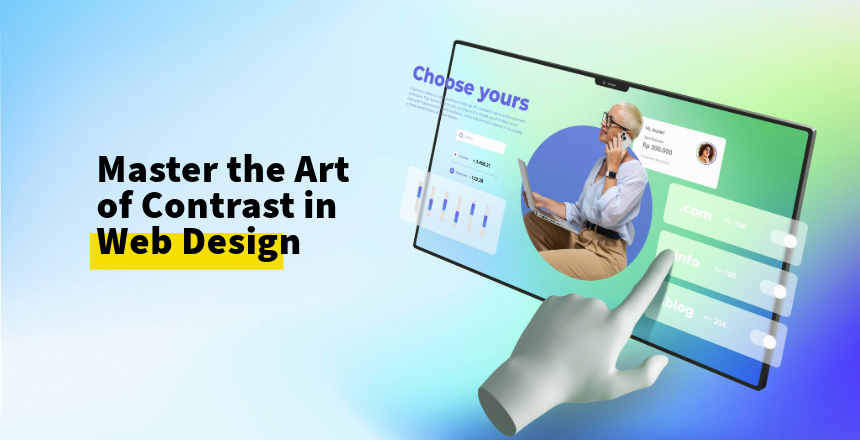In today’s competitive digital landscape,
creating websites that are not only visually appealing but also accessible to
all users is crucial. A significant aspect of web accessibility often
overlooked is contrast—a vital
design element that plays a pivotal role in making your content readable and
your website usable for everyone, including individuals with visual
impairments.
The Web
Content Accessibility Guidelines (WCAG) were developed to help designers
and developers create accessible digital experiences. These guidelines set the
standards for ensuring that web content is perceivable, operable,
understandable, and robust. One key area WCAG focuses on is color contrast,
which can dramatically affect how users interact with your website.
In this blog post, we will dive deep into
the importance of contrast in web design, outline three key insights from WCAG
guidelines, and provide actionable tips to help you design inclusive websites
without compromising aesthetics.
Why is Contrast Crucial for
Accessibility?
For many users, especially those with
vision impairments, low contrast can make reading text or navigating a website
challenging, if not impossible. Imagine trying to read light grey text on a
white background—frustrating, right? This is a common design mistake, and while
it may look sleek, it creates a barrier for users who rely on clear visibility
to engage with your content.
By ensuring proper contrast between text
and background, designers can make websites more usable and accessible, which
leads to better user experiences and higher retention rates.
1. Understanding WCAG
Contrast Ratios
WCAG outlines specific contrast ratios
that must be met to ensure legibility. These ratios refer to the difference in
luminance between the foreground (usually text) and the background. The higher
the contrast ratio, the easier it is for users to read and comprehend the text.
●
For regular text (below 18pt or
14pt bold), the minimum contrast ratio should be 4.5:1.
●
For larger text (18pt or larger,
or 14pt bold and above), the contrast ratio can be slightly lower, with a
minimum requirement of 3:1.
These ratios are designed to ensure that
people with low vision, color blindness, or age-related vision loss can still
access and interact with your content.
Tip:
Use online contrast checkers, such as
WebAIM’s contrast checker, to ensure that your text and background colors meet
the necessary WCAG standards. This simple step can prevent major accessibility
issues down the line.
2. Focus on More Than Just
Text: Non-Text Contrast
Contrast isn’t just about text; it also
affects non-text elements like buttons, icons, and links. WCAG requires that
these interactive elements be easily identifiable, even when viewed by
individuals with color blindness or other visual impairments.
Low-contrast buttons or links might blend
into the background, making it difficult for users to know where to click or
how to interact with your site. WCAG recommends ensuring interactive elements
are clearly distinguishable from their surroundings using visual markers such
as outlines, borders, or shapes.
Tip:
When designing interactive elements like
buttons or form fields, make sure they stand out by using both color and shape.
For example, use a combination of bold text, borders, or iconography, alongside
contrasting colors, to ensure users can easily identify these elements.
3. Striking a Balance Between
Accessibility and Design Aesthetics
As a designer, you may worry that
focusing on accessibility will limit your creativity. But the truth is,
accessibility and aesthetics can go hand-in-hand. Following WCAG guidelines
doesn’t mean your site will look plain or boring—it simply ensures that
everyone can access your content without obstacles.
Designers can play with contrast and
still maintain their brand’s visual identity. By choosing contrasting shades of
your brand’s colors, you can meet accessibility standards without sacrificing
design quality.
Tip:
Test your design in various environments. Users may
visit your site in different lighting conditions, so ensure that your color
contrast holds up in both bright and dim settings. Using a darker version of
your brand’s color palette for text or buttons can make your site both visually
appealing and accessible.
Conclusion: Prioritize Accessibility, Foster
Inclusivity
Creating accessible websites isn’t just
about compliance; it’s about crafting a digital experience that is inclusive to
all users. By following WCAG guidelines, particularly those around contrast,
you can make your website more usable, welcoming, and engaging for a broader
audience.
Remember, accessibility is a shared
responsibility for designers, developers, and content creators. It’s not just
about ticking boxes; it’s about fostering an inclusive environment where
everyone can participate.
What’s
your take on WCAG and contrast in design? Let us know
in the comments below how you ensure your websites are both accessible and
aesthetically pleasing.
By committing to accessibility, you’re not just meeting legal requirements—you’re designing for a more inclusive digital world.


